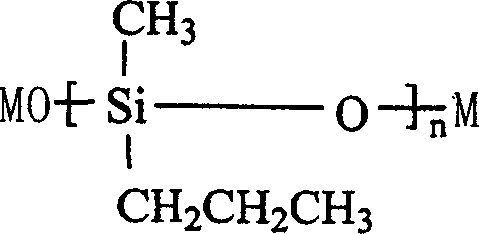Fluorine-silicon compounded rubber stock and method for making same
A technology for mixing rubber and fluorosilicon, which is applied in the field of fluorosilicone rubber and its preparation, can solve the problems of prolonged production cycle, increased difficulty of process control, complex polymerization process and the like
- Summary
- Abstract
- Description
- Claims
- Application Information
AI Technical Summary
Problems solved by technology
Method used
Image
Examples
preparation example Construction
[0046]The preparation method for preparing the fluorine-containing silicon polymer of the present invention comprises adding a catalyst composition to the monomer mixture, and the amount of the catalyst composition added accounts for 0.004%-0.010% of the total weight of the monomer mixture. The best is 0.005-0.006%.
[0047] The catalyst composition comprises:
[0048] a) silicon alkoxide compounds having the general formula:
[0049]
[0050] Wherein, n is an integer of 40-60; M is an alkali metal element selected from Na or Li.
[0051] b) fluorine-containing silicone oligomer, which is selected from methyl fluorosilicone oil, hydroxyl fluorosilicone oil, vinyl fluorosilicone oil;
[0052] The weight ratio of the silicon alkoxide compound to the fluorine-containing organosilicon oligomer is 1:1 to 50:1, preferably 20:1-40:1.
[0053] The silicon alkoxide compound used in the catalyst composition can be prepared according to the following reaction equation:
[0054] ...
Embodiment 1
[0097] 10kg D 3 F Monomer (purchased from Zhejiang Sanhuan Chemical Co., Ltd., purity > 99.0%), 2g of methyl fluorosilicone oil as a molecular weight regulator (purchased from Shanghai Sanaifu New Material Co., Ltd.) and 50g D 4 MeVi Filter through a 2# sand core funnel, and add it to a pre-dried 20L stainless steel polymerization reactor. Add 40 grams of the above-prepared sodium silanolate catalyst component (the degree of polymerization is about 55) into the catalyst dehydrator, leave about 500 g of monomer mixture on it, heat it with an infrared lamp, and heat it with steam in the kettle to control the temperature at 70 ± 3℃ / 1333.22~2666.44Pa, dry with N 2 Carry out pre-dehydration for 1.5hr, and then put the upper part D 3 F Put a small amount in the catalyst dehydrator, soak in alkali for dehydration for 0.5hr, put the catalyst component into the kettle within 15min, wash with the monomer left on the upper part, put all the rinsed monomer into the kettle within 15mi...
Embodiment 2
[0104] The steps described in Example 1 were repeated, except that the amount of the sodium silanolate catalyst component was 60 grams. The results are listed in Table 1. Six points were taken at different positions of the obtained polymer to compare the molecular weight distribution, and the results are listed in Table 2.
PUM
| Property | Measurement | Unit |
|---|---|---|
| tensile strength | aaaaa | aaaaa |
| tensile strength | aaaaa | aaaaa |
| particle size (mesh) | aaaaa | aaaaa |
Abstract
Description
Claims
Application Information
 Login to View More
Login to View More - R&D
- Intellectual Property
- Life Sciences
- Materials
- Tech Scout
- Unparalleled Data Quality
- Higher Quality Content
- 60% Fewer Hallucinations
Browse by: Latest US Patents, China's latest patents, Technical Efficacy Thesaurus, Application Domain, Technology Topic, Popular Technical Reports.
© 2025 PatSnap. All rights reserved.Legal|Privacy policy|Modern Slavery Act Transparency Statement|Sitemap|About US| Contact US: help@patsnap.com



